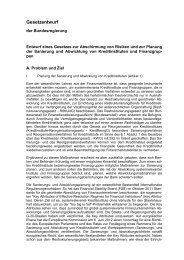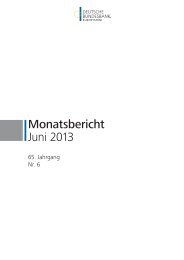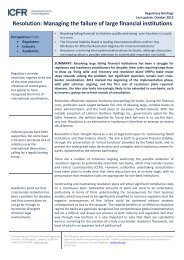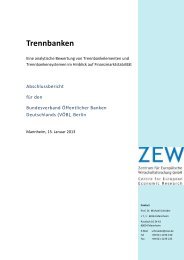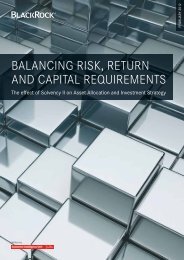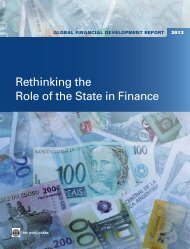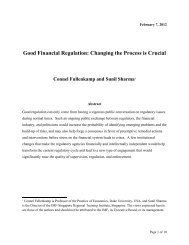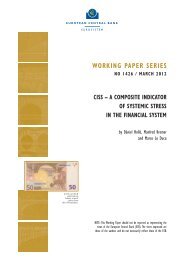3 Issuing costs of state guaranteed bonds - Financial Risk and ...
3 Issuing costs of state guaranteed bonds - Financial Risk and ...
3 Issuing costs of state guaranteed bonds - Financial Risk and ...
Create successful ePaper yourself
Turn your PDF publications into a flip-book with our unique Google optimized e-Paper software.
4 Impact <strong>of</strong> <strong>state</strong> <strong>guaranteed</strong> <strong>bonds</strong> on bank lending, funding <strong>and</strong> pr<strong>of</strong>itability performance<br />
Figure 20: Credit growth <strong>and</strong> bank lending st<strong>and</strong>ards<br />
82<br />
Bank credit to private nonfinancial sector<br />
-5 0 5 10<br />
-5 0 5 10<br />
Euro Area<br />
2003 2004 2005 2006 2007 2008 2009<br />
UK<br />
2003 2004 2005 2006 2007 2008 2009<br />
-20 0 20 40 60<br />
-20 0 20 40 60<br />
Bank lending st<strong>and</strong>ards<br />
Bank credit to private nonfinancial sector Bank lending st<strong>and</strong>ards<br />
Note: 1 Bank lending st<strong>and</strong>ards (net percentage change, a positive number indicates tightening <strong>of</strong> st<strong>and</strong>ards. Net percentage change<br />
refers to the difference between the percentage <strong>of</strong> banks that tightened st<strong>and</strong>ards <strong>and</strong> the percentage <strong>of</strong> banks that eased st<strong>and</strong>ards.)<br />
2<br />
Bank credit to private nonfinancial sector (year-on-year percent changes through June 2009.)<br />
Source: IMF (2009): Haver Analytics <strong>and</strong> national sources<br />
However, Figure 20 also shows that despite a tightening <strong>of</strong> credit conditions, lending st<strong>and</strong>ards <strong>of</strong><br />
banks in the Euro area <strong>and</strong> the UK were loosening by the end <strong>of</strong> 2008, which is consistent with<br />
banks seeking to extend more loans than they previously were.<br />
The present study analyses trends in lending <strong>and</strong> other balance sheet variables in greater detail.<br />
Firstly, through consideration <strong>of</strong> the period October 2008 to December 2010, which includes more<br />
recent data than was available at the time <strong>of</strong> previous studies, we are able to analyse responses <strong>of</strong><br />
balance sheet variables to <strong>state</strong> guarantees that may be emerging with a time lag.<br />
Secondly, by focusing on individual bank data as opposed to aggregates, we distinguish<br />
developments in the balance sheets <strong>of</strong> banks participating <strong>and</strong> not participating in <strong>state</strong> guarantee<br />
schemes.<br />
And thirdly, we use a difference-in-differences framework that allows us to isolate the impact <strong>of</strong><br />
<strong>state</strong> guarantees <strong>and</strong> control for other policies <strong>and</strong> changes in market conditions that may have<br />
affected both participating <strong>and</strong> non-participating banks.<br />
The following sections present an analysis <strong>of</strong> the effects <strong>state</strong> guarantees on bank lending,<br />
leverage <strong>and</strong> pr<strong>of</strong>itability.<br />
Section 4.3 provides a descriptive analysis <strong>of</strong> the impact <strong>of</strong> the issue <strong>of</strong> <strong>guaranteed</strong> <strong>bonds</strong> on<br />
banks' performance.<br />
Section 4.4 presents the statistical methodology generically, as applied to credit extension.



